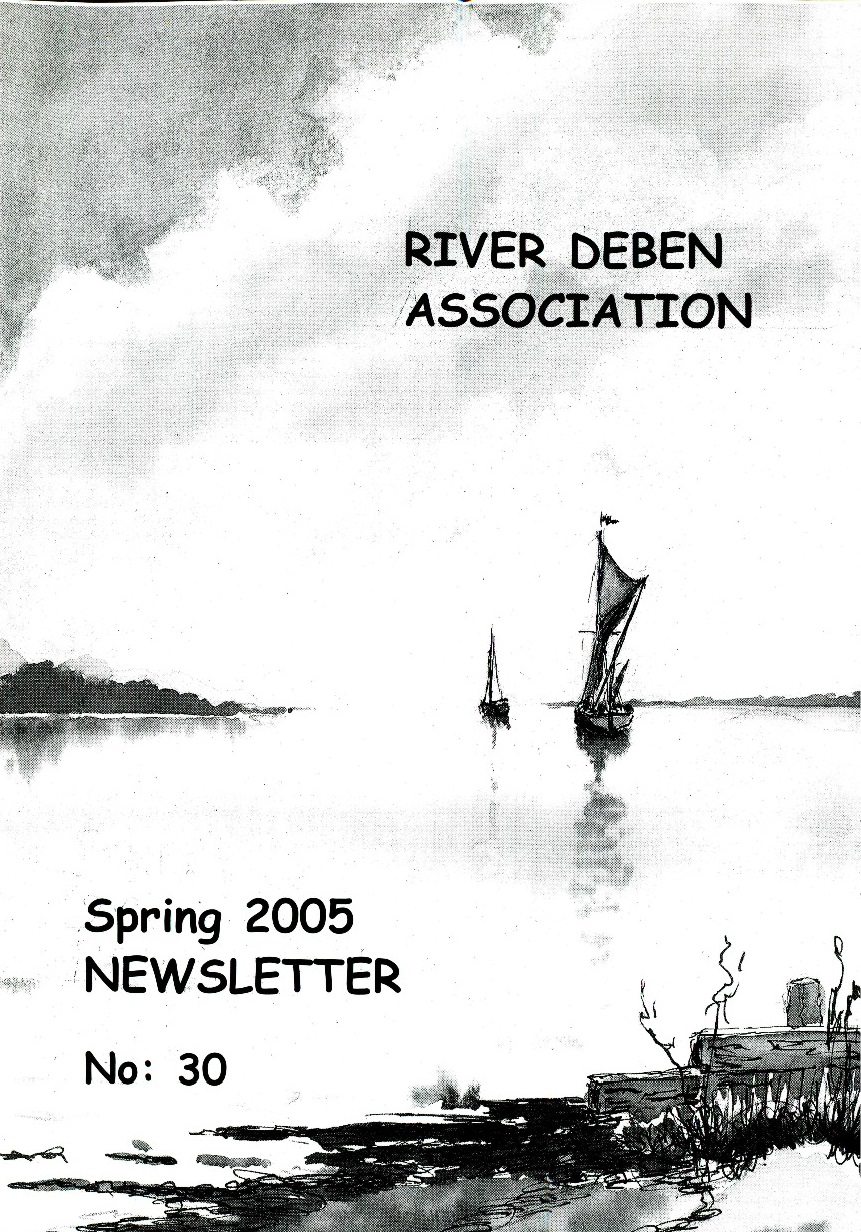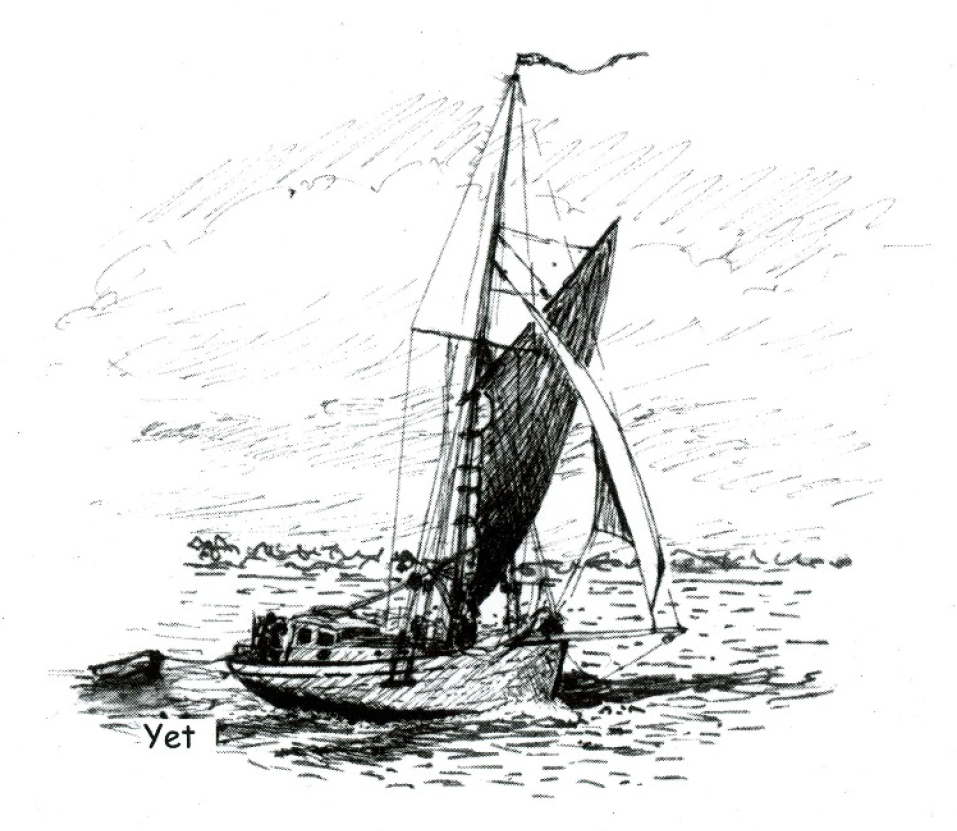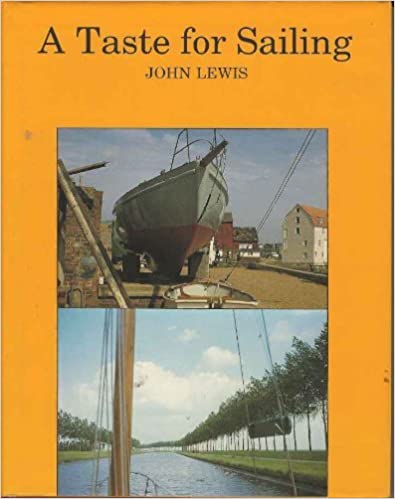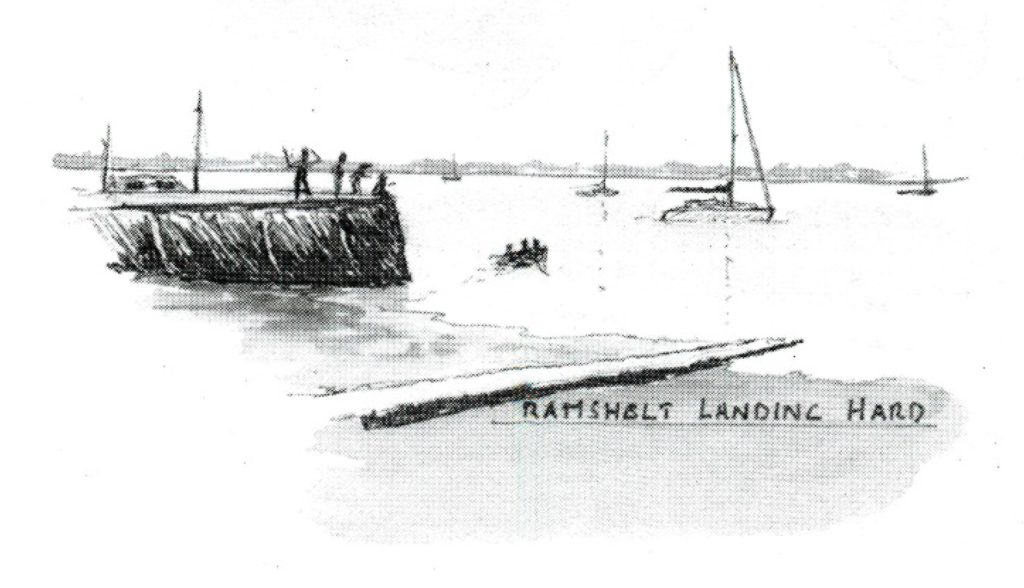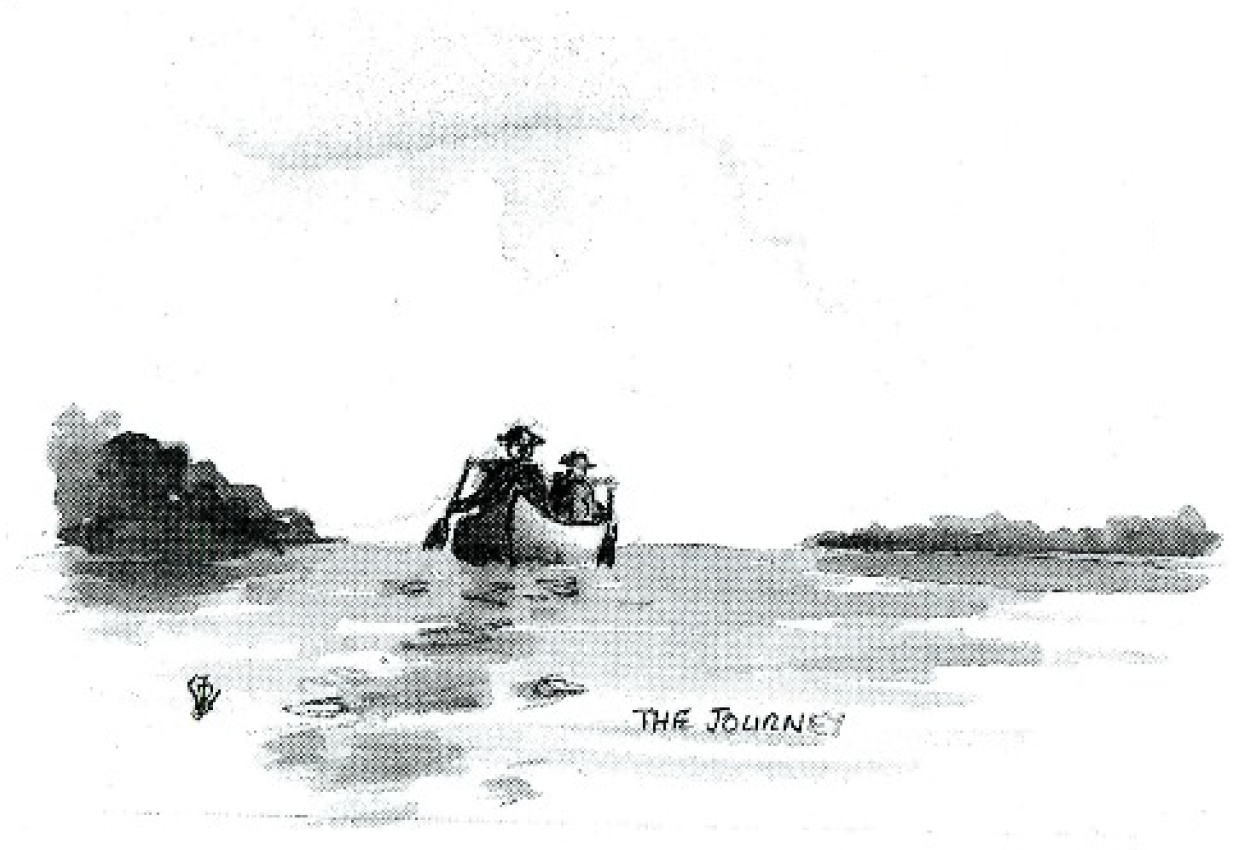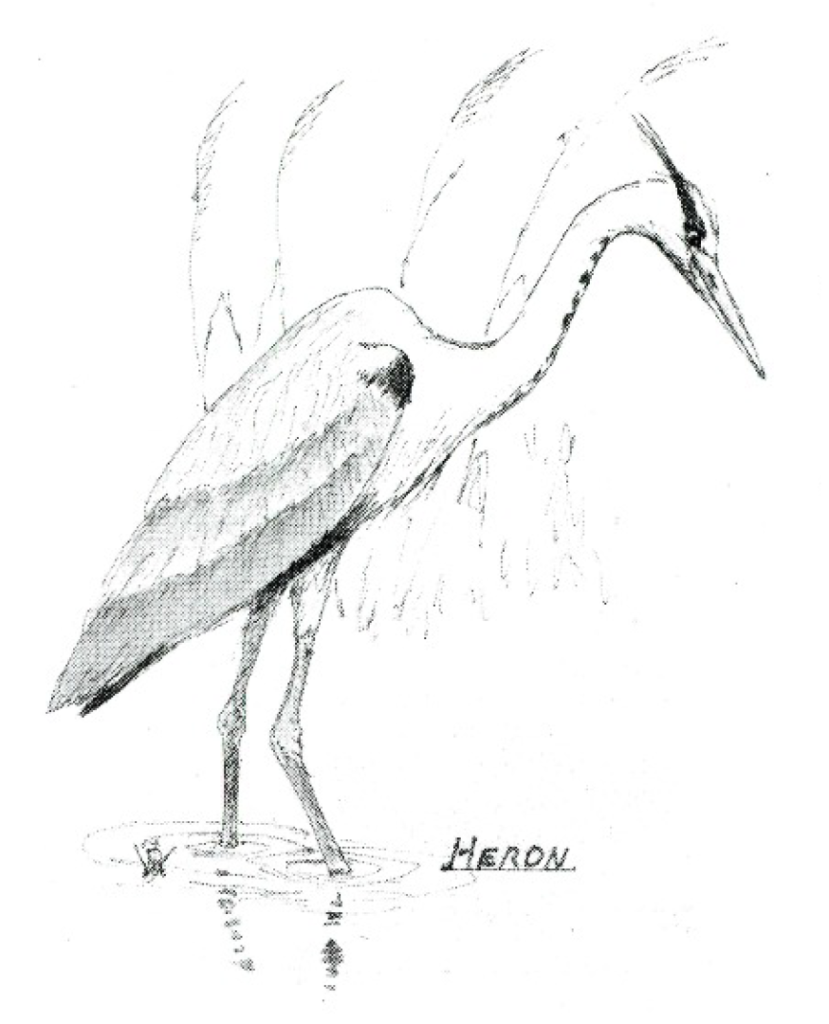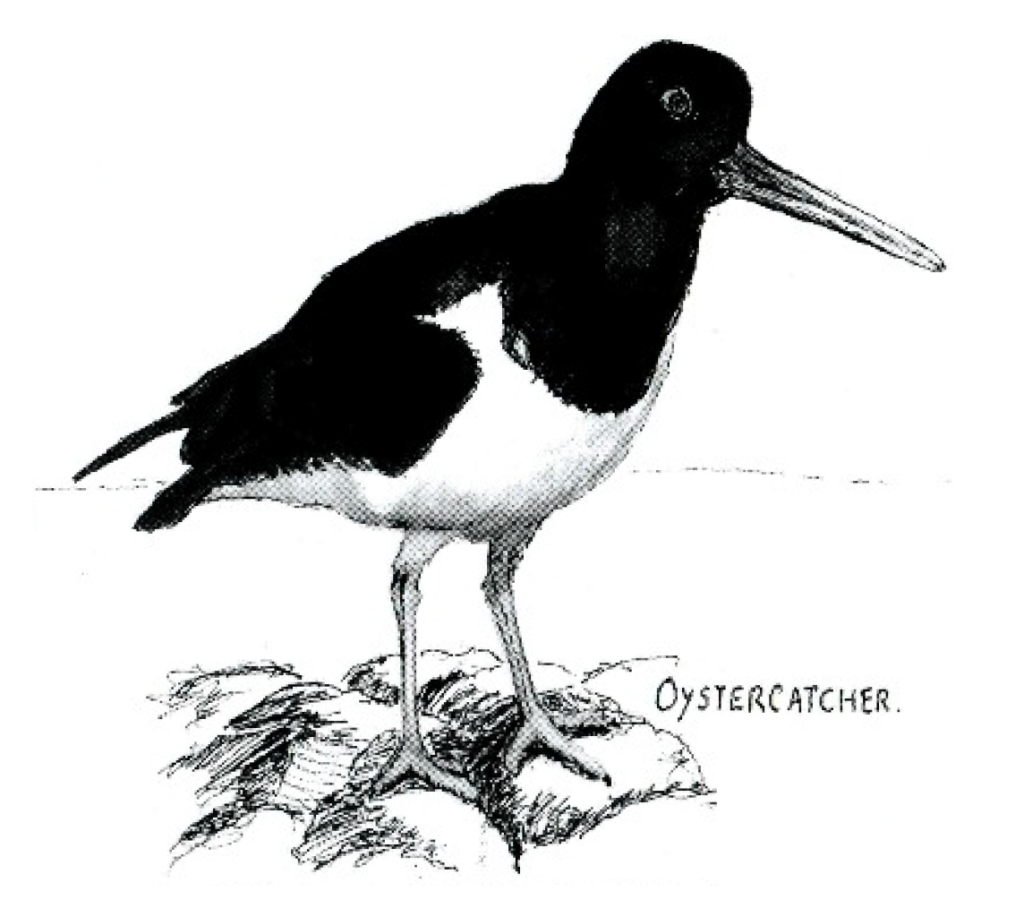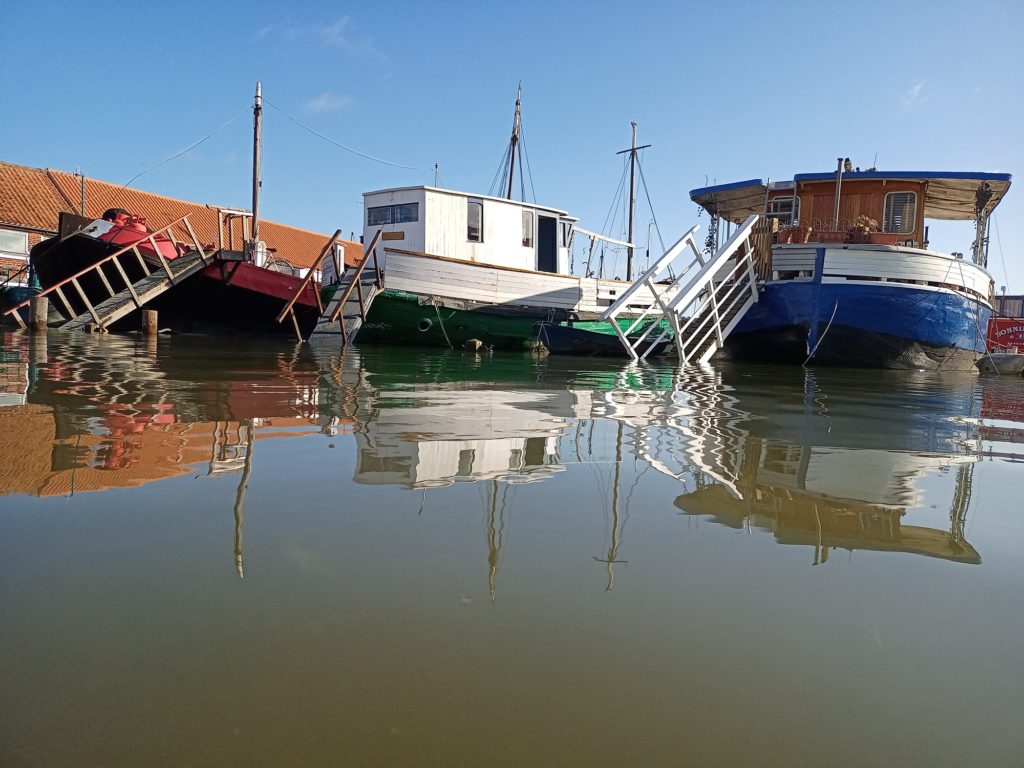by Bertie Wheen
This is the second part of the second post in a series (in which I’ve been sharing a few of the things I’ve been finding while I’ve been going through our magazine archives). The first post was Once Upon a Time… (which covered the 1990s), and the first part of this post was News from the Noughties, Part I (which included roughly the first half of the 2000s). I’d recommend reading those before this (which, unsurprisingly, will feature the rest of the 2000s), but much more than reading any of these, I’d like to recommend going directly to the source, and having a leaf through some of the old editions (available on our magazine page).
This is what the RDA Newsletter cover looked like between 2004-2010. The font choice is a bit questionable, but I’m a fan of the drawing – though I’m not honestly sure which stretch of the Deben it is… looking upriver from the Rocks, or perhaps the Tips? [I have since been informed that it is likely looking downriver from Kyson, and I not only agree, but feel a bit stupid as that is probably the bit of river I know best…] Anyway, I do know that it was drawn by Ron Wragg, thanks to Nick Wright’s inaugural editorial in Spring 2004 (#28, the last issue mentioned in the previous part of this post):
“I would like to make a special mention of Ron Wragg who has donated the art-work which decorates the cover and punctuates this Newsletter. I hope that contributors will forgive me for occasionally replacing their excellent photographs (which do not reproduce well) with his sketches, some of which are based upon them. This represents a lot of work for Ron. I appreciate it very much.”
I love the little illustrations of Ron’s that pop up in the old newsletters. We are very lucky these days to be able to fill the modern magazine with pictures (in colour!), but they certainly managed before doing that was possible. Ron’s other contribution to the magazine (apart from his drawings) was a piece in Spring 2006, “An Early Affair”:
“My affair with the River Deben began in the mid 1950’s. I was a teenager and a pal of mine suggested a jaunt. I rode pillion on his motorbike and we went, for the first time, to Felixstowe Ferry. I was a town boy, brought up near the busy Ipswich Docks, full of majestic Thames Barges. By contrast, Felixstowe Ferry with its little fishing boats looked quaint and old-fashioned, and pleasantly scruffy. I recognised the hulls of half a dozen old flying boats, wingless and propped up on the shore where now the house-boats are moored. I still found them exciting because I loved aeroplanes. We wandered round, lost in a world that seemed slow and comfortable, governed by tides and not clocks.”
In the Spring 2004 edition, Frank Knights had shared some of his own early memories, in a piece called “Early Days in Small Boats”. It’s a real gem, and worth reading whether you knew him personally, or as a personality, or not at all! I find it quite inspirational (or motivating, if that sounds too hyperbolic), because it reminds me that you don’t need top-tier gear to have fun messing about in boats:
“As I was now in possession of a much more weatherly boat [than the elderly wooden skiff he’d purchased for £2-12], my thought turned to having a try at sailing. My dinghy was only meant to be used with oars, so it had to be converted by fitting a mast. Having acquired a [second hand] spar, this was stepped through the fore thwart. A centre board and rudder was not considered essential as we could steer with an oar, row to windward, and sail back, if we could obtain a sail! By this time I had made friends with a new near neighbour who had come from Harwich with his parents. Frank (also a Frank), coming from the seaport of Harwich, was very much more of a sailor than me. I still had no sail, but the other Frank solved this by borrowing his mother’s striped sun-blind, which made a quite serviceable square sail. We then made a number of one-way sailing trips.”
I did nearly get whiplash from the next paragraph though:
“Sadly, Frank lost his life at sea when his ship was bombed off Orfordness. He now rests in Melton old churchyard.”
By the way, if you do read it – which, again, you absolutely should – and particularly if you read the last paragraph in which he mentions selling his smack Yet the year before (“a good friend to me for almost sixty-five years”), you might be interested to know that in the subsequent issue (Autumn 2004) there’s an article by him about her – it’s great, and you should read it too.
An aside: in it he mentions that he bought her in Brightlingsea “a few days before the white Christmas of 1938”. I didn’t know there was a white Christmas that year, but I’ve just had a quick google and apparently it was one of the whitest Christmases of the 20th century. Now of course, Irving Berlin was American, but I wonder whether that’s partly the reason “White Christmas” got so popular here? I mean, obviously there are many reasons, but Bing Crosby first sung it on Christmas Day 1941 and recorded it in May 1942, and I imagine that if you were in the British Armed Forces in the latter part of the war, you may well have been dreaming of a white Christmas, specifically the one you knew in 1938. Anyway, I realise this is quite random, but I wanted to write it regardless.
I often find people’s understated descriptions of the war and the run-up to it quite surreal, and Frank gave a good example of the “Keep Calm and Carry On” approach:
“Those early months of 1939 were used to sort out the smack and make her more suitable for pleasure cruising. Although the international situation was looking a bit grim, following the Munich agreement, I was able to use Yet quite a lot at week-ends, with and without crews, and the sailing season passed very quickly (it always seems to).”
Another thing that happened in 1938 was Peter Uloth and his family first coming to the river. He describes it in an article that immediately precedes Frank’s “Early Days” one (and which was supposed to be the first in a little series, but – not for the first time – ended up being the only installment). As someone born relatively recently, this paragraph was eye-opening (and it made me wish for a time machine…):
“We had entered a river such as we had never before seen, with trees right down to the banks. That was of course long before the Elm disease had taken its terrible toll, but even today the Deben is beautiful and unique.”
(I’ve heard of Dutch Elm Disease, but I hadn’t really considered its effects; I’ve thought fairly frequently about what it would have been like in ancient times when everywhere was still old-growth forest, but I hadn’t realised that quite recently the Deben was noticeably more wooded than it is today.)
And as someone who grew up on a Kyson mooring, the one after it gave me a good chuckle:
“The next morning we spied the “gleaming spires” of an attractive other-place nearly hull-down in the distance. We enquired whether we would be calling there. “Not likely!” was father’s reply, “look at the chart, it shows ‘Troublesome Reach’ before you get to Woodbridge. I am not going to risk my ship negotiating such a hazard”.”
Later in the article Peter mentions that Mijn Klomp (his clog — sorry, his boat) was at one time in her past the Woodbridge-Sutton ferry. (1985-1990?) Now, I’ve always felt sad that the Woodbridge Ferry isn’t still a thing, and though I know that it probably doesn’t make sense for it to be, that hasn’t stopped me wishing that it was. I then discovered an article by Robert Simper in the Autumn 2004 edition called “Deben Ferries” that is, at least for me, a rollercoaster. Reading it I went back and forth between “it can’t be a thing” and “it can be a thing!”, and I’m not going to quote the whole thing, but if you’re interested in the ferries it’s worth a read. (And, look, I don’t know what other people’s views are, but I’m just going to say that surely the developments since then will have increased the number of potential customers…)
There have been various bits about boats (like, specific boats) that have appeared in the magazine/newsletter over the years. Mostly these have been written, but there was one that I meant to mention in Once Upon a Time… that was drawn by Claudia Myatt, accompanied by logs from the Masters, on the occasion of Clytie‘s 75th birthday – look in the back of #15, Autumn 1997. As you might know, or if you are arithmetically inclined as you might guess, she turned 100 on the 28th of last month.
While I’m mentioning things from the 90s that I should have signposted, I just want to quickly quote a very special article by Jenny Auber, “The Deben Estuary – A Very Special Place” (Autumn 1999):
“We’ve been on it, under it, over it, through it and across it. We’ve been up it and down it, in it and out of it. We’ve swum in it, splashed in it, fallen in it and sunk in it. We’ve poddled by it, paddled in it and piddled in it. We’ve smelled it and drunk it and been sick in it. We’ve lost watches and glasses and boathooks in it, and found fenders and boathooks, and delight in it.”
Anyway, going back to bits about boats, I’d like to mention “A Few Days on Patient Griselda”, a lovely little trip report of some East Coast cruising by John Symes in Autumn 2007:
“Going below to make a hot drink or snack, I so enjoy the noise of a boat underway, especially a wooden one with the creak of the gaff on the mast, the water going by and all the other noises. It’s music to my ears!”
Sidenote: you may know Patient Griselda from A Taste for Sailing, written by her original owner John Lewis, the cover of which shows a very different Whisstocks! (And some very much unchanged Dutch canals.)
Just before the piece by John Symes is an absolute joy of an article by Darrell Smith-Lyte entitled “What Would Biggles Have Done?” about a night of tribulations involving his Tregenna‘s seacocks. I can do no better than to tell you it’s on page 12, and that if it doesn’t make you smile I don’t know what will.
The previous Autumn (2006), people had also had cause to smile – or, perhaps, to sigh with relief: Robert Simper announced that the case he had been fighting – with the support of many, including the RDA – was won. I imagine you will either know what the case was, or be a bit shocked to learn it needed to be fought – I certainly was. It involved the Ramsholt Landing Hard, and though I’m not going to explain it in detail (if you want to learn more, Robert additionally wrote on the matter in Spring 2005), the gist of it is this: The Bawdsey Estate had begun claiming that the hard (plus the path between it and the Arms), which had since time immemorial been a public right of way used freely by (and maintained by) boat owners (and other members of the public), could now only be used by those who had the Estate’s permission, which might be obtained by paying them a fee (or, in the case of those who kept their dinghy there and already paid them a fee – which had been recently doubled, and had never been used for maintenance of the hard – an extra fee).
Robert, having “sought advice from the Suffolk County Council”, had been “assured […] that they would recognise a public right of way footpath from just outside the Arms to the end of [the] Hard, but that the quay and dinghy park were obviously private property. So far so good, but then for some extraordinary reason the Suffolk County Council suddenly reversed this decision and ruled that there was no right of way.” He lodged an appeal, and the case continued – and, as is the way with such things, it got expensive and took years:
“The total cost of this case, thus far, has been around £11,000, so I could not have kept going without the help of the RDA, yacht clubs and individual boat-owners who kindly gave money. Most of the cost was borne by the Ramsholt Fairway Committee. Harbour Master George Collins and Secretary Tom Owls stood staunchly by the action. Many other river-users, including Richard Ballam, also loyally supported the action with advice and information.
Johann Wylly, of Mills and Reeve, took on the action. We managed to collect 345 written evidences, a large number of these having been rounded-up by Rosemary Schlee, from people who said they had always used the Hard as a public right of way. Forty-five of these evidences were from people who had used the Hard before 1965 and we even had a few from before 1939. The Bawdsey Estate submitted two written evidences from people who said they believed it to be private land.
There then followed a wait of nearly three-and-a-half years for the Government ruling. Finally, in August 2006, Erica Eden of the Planning Inspectorate at DEFRA, Bristol, upheld my appeal and Julie Hume of DEFRA Rights of Way, Newcastle, agreed with Ms Eden’s findings and wrote to the Suffolk County Council saying that it should recognise the Ramsholt Boat Hard and the path leading to it as being a public footpath.”
I am very glad that the eventual decision was the right one, and very thankful for all those whose support has enabled me (and countless others) to land on the hard more times than I can remember. Hell, I even landed on it many times while all of this was happening, but being a child then I was blissfully unaware of the drama.
It is, of course, frustrating that the matter ever needed to be, as Robert put it, “discussed”, and that such a simple thing, with such an obvious solution, required as much time, money and persistent, concerted effort as it did. It’s frustrating that that is usually how it is. But it is inspiring that people care enough to put in those resources, and effect positive change – or in this case, resist negative change. It helps heal my bruised faith in humanity, and it makes me sure that the RDA and organisations like it – and the people that they comprise – are a good thing. Remember our first two founding objectives:
- To encourage any proposal which would safeguard the River and supports appropriate future developments.
- To resist any proposals which have a detrimental effect on the river and its environs.
It can be hard work, but someone’s gotta do it!
Speaking of hards… If you read the magazine (which I hope you do), you’ll have guessed where I plagiarised this post’s title from: our regular column, “News from the Hards”. In my defence, Denzil Cowdry started the first one (which at the time was “News from the Hard”) by admitting that he’d done the same:
“The title of this new, perhaps regular, contribution to the Newsletter is an admitted plagiarism. Doing some family history research in Brightlingsea museum, I came across some hundred-year-old Parish Magazines with a similar column. Typically there were comments such as:
“YACHTING – The River Colne has presented a remarkably fine show of yachts, both steam and sailing craft, in the course of the last month, prominent amongst them being the splendid American SY Venadis, 1,283 tons. With fully the average number of yachts in commission, we don’t think there are many of our yachtsmen without a berth.” In those days Brightlingsea lived off fishing and yachting, so the gossip from the hard mattered a lot.
No doubt the Whisstocks hard in Woodbridge, reputedly the longest, best equipped and deepest on the East Coast, occasioned a similar interest. Here the talk would have been about barges, freight rates, crops, vessels under construction and timber supplies, as well as about yachts. Well covered with mud, the hard is a sad, inactive sight today, awaiting development of the adjacent land. However, if the demands of the lobby group are met, there will be more space for the public to congregate at the top of the old hard, to gossip and enjoy the river in all its moods.”
Thankfully, this space in the newsletter for gossip (more about vessels under construction than freight rates) was not one of the one-offs, and did become a regular feature: Denzil followed its debut in #34 with “News from the Hard”s in #35-37, and in #38 but there instead called “Talk on the Hard”. It was missing from #39 (Autumn 2009), but only from that issue – it reappeared in #40 (again as “News from the Hard”), though it would be the last time Denzil would write it. (And – spoiler alert, because this should be in the next post – it would be the last Newsletter!)
While we’re on the subject of last articles (though perhaps not lingering on it), I might mention that Rosemary Schlee’s was in Autumn 2005, and is quite enjoyable, and short enough for me to quote almost in full:
“Two ladies well past 70 decided to canoe to Letheringham Mill, having got permission to land there. After consulting with local canoeists, we were told to go to Sanctuary Bridge near Easton Farm Park where we would find a proper launching slip. We found it, and then brought the car through the gate onto some rough land so as to unload the canoes right by the river. After a delightful paddle to the Mill, we returned to find the gate padlocked so that the car was immobile. We were considerably alarmed as, even if there was a nearby phone box, we had only a £10 note! We seriously visualised having to hitch-hike back down the A12 to Melton.
But then we heard a tractor, a good way off. The driver kindly phoned his boss, saying “Sir, they don’t look like New Age Travellers”. He passed me his phone and I told the boss that we were definitely Old Age Travellers. Eventually, to our great relief, we were set free. We have since discovered that you can paddle up there, with private land on both sides, if you obtain permission beforehand, and we might be brave enough to have another go.”
As well as being an Old Age Traveller-cum-canoeist, she was then the RDA’s Press Secretary, as she continued to be until her death in 2008. She was, as Denzil pointed out in his tribute to her that Autumn, other things besides, and helped the River Deben and the Association a great deal:
“She had been a founder member and then a Committee Member of the Association since the early 1990s, [and] a friend of the River Deben for more than 50 years. […] She was a very competitive dinghy helm, in a Kingfisher dinghy and then a Wayfarer, and had a great number of friends and acquaintances, most of them made through racing and teaching sailing.”
“From small exchanges on the beach at Waldringfield, the Association has grown to have a membership of 800 and has the respect of decision makers for sound judgements, based on the opinions of the members. Significant events have been the involvement with the Felixstowe Foreshore to acquire land that would frustrate a proposal for a marina at Felixstowe; the opposition to the Bentwaters plan for an international airport with an outward flight path down the Deben; and the Whisstocks site-planning enquiry for the proposed high profile residential estate.
Rosemary played an active part in all these main issues as well as in inumerable [sic] small ones. Two of these latter were peculiarly her own. The first was the disposal of unsightly wrecks on the banks of the river towards Wilford Bridge, for which she harassed Suffolk Coastal officials until they provided a share of the funds for the work. The second, quite recently, was to keep the path along the river bank to Wilford Bridge open, which had become enclosed by a leasee. Collecting two hundred signatures to complicated forms to prove former use of the path was one part of this operation. Rosemary tackled this single-handed, once again proving to be a good person to have on our side.
She will be remembered fondly by many members on a personal basis.”
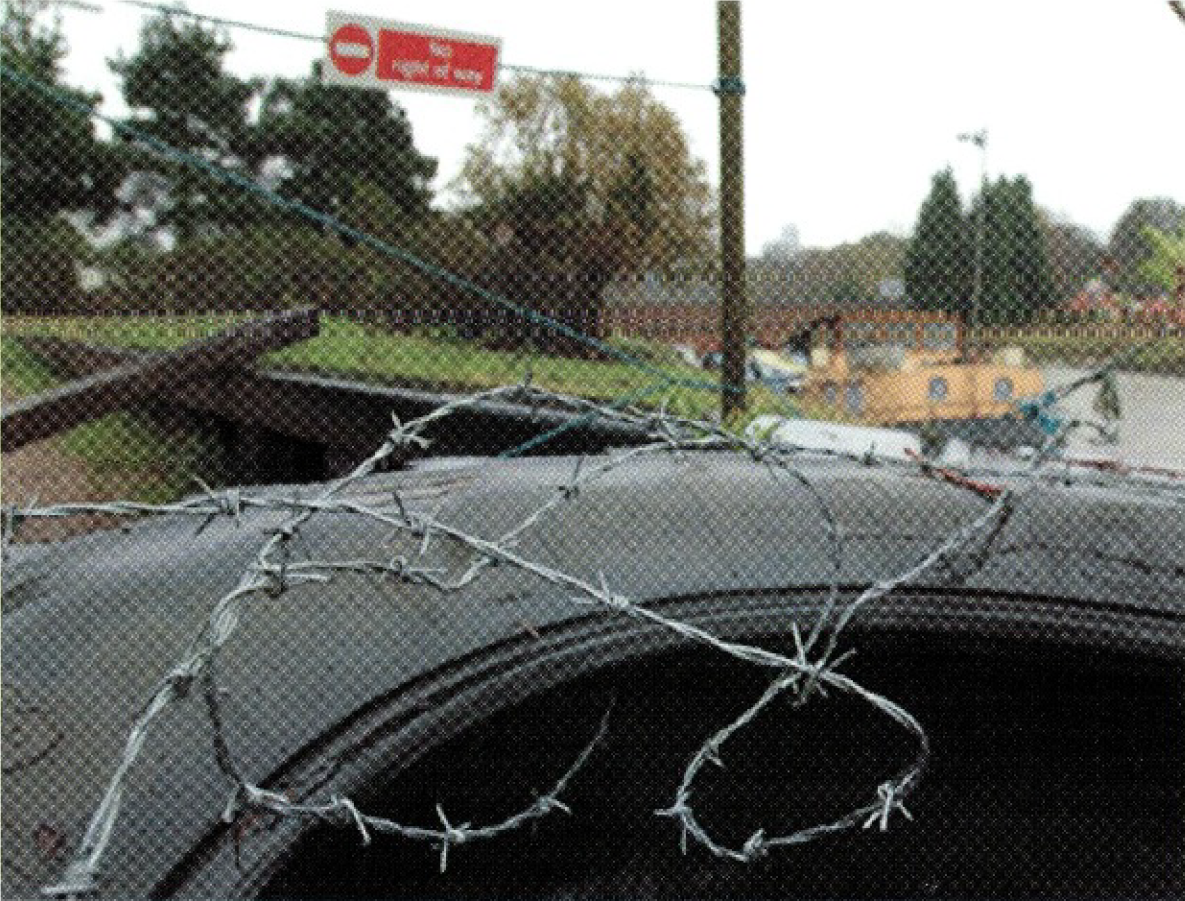 The Wilford Bridge blockade. Photo: Daniel Hambury
The Wilford Bridge blockade. Photo: Daniel Hambury
That thing about the path to Wilford Bridge was similar in many respects to the Ramsholt Hard affair. I won’t discuss it here, and will instead say that you can look on the last page of the Spring 2003 Newsletter to find out about it.
On the same spread as Denzil’s tribute to Rosemary, was a STOP PRESS box announcing the death of Frank Knights. This is one of the first things that feature in the Newsletter that I remember happening – I was 13 at that point, and by then we had owned a houseboat moored on his quay, Goldenray (aboard who I still live, though the quay is now owned by Sam and Emma Jennings rather than Frank and Christine), for a few years, but had known about him since well before then. He and his wife were local legends, and when I remember them I remember happy childhood memories.
The subsequent newsletter had a transcript of the address given by Robert Simper (himself a local legend) at a ceremony held to celebrate Frank’s life. In “Frank Knights, A River Deben Personality”, Robert put it very well, describing him as “a sort of benevolent Godfather of Woodbridge waterfront”:
“All he actually did was run a small boat yard in Woodbridge. Yet he was the most popular and liked man in this town. To be genuinely liked by a few people is an achievement; to be liked by a whole town was damn near unique.”
I’d quote more, but – as with most things, though more than most of them – it’s better if you just go and read the actual thing: it’s in the Spring 2009 newsletter (#38), and it starts on page 8.
Now, I’m afraid that – as I seem to be making a habit of – I am rather running out of time. 5 o’clock, when this post should be published, is looming, and thus I must be briefer than is deserved with the remaining few things I want to highlight.
One of them is Jenny James, a sort of precursor to Sally Westwood, who contributed 7 articles in the 10 issues between 2005 and 2009 (#30-#39), all but one of them about Deben birds. (The other, in Spring 2008, was about oak and ash trees.)
I was pleased to read in her Spring 2006 article that “there will always be a few nightingales which do establish territories by the Deben”. This summer I was again and again noticing some really remarkable birdsong on walks between Woodbridge and Kyson. Not knowing what it was (I know shamefully little about birds in general), I got googling until I had eventually decided that the singers were probably nightingales, or possibly song thrushes. While listening to them on a later walk, I was assured by someone walking the other way that they were song thrushes. I doubted this, but as I am fairly clueless about birds I wasn’t in much of a position to disagree. Thus, though this is of course not conclusive evidence (it’s possible that there are both here), I will admit to feeling somewhat vindicated.
Her Autumn 2009 contribution was on saltmarsh birds, and it is a great lesson in how vital the saltmarsh is to so many species. Hers was accompanied by another piece about our saltmarshes, written by Simon Read. As you hopefully know (if you don’t, you can read the recent magazines for the latest on the situation), there is an ongoing crisis in that we are as a river losing our saltmarshes. He had noted the problem in the newsletter as early as Spring 2004:
“We know that our river is silting up in its upper reaches. We can see that the salt marshes fronting the river walls are becoming depleted. We are perhaps aware of the age and potential inadequacy of many of our flood defences. We will all have our favourite culprits and preferred solutions, but the certainty is that, yes, this is all taking place and, yes, remedial action has to be undertaken. I, for one, am intrigued by the connection between the loss of salt marsh and the accretion of silt. Are there ways in which the creation of salt marsh habitat by realigning flood defences can go hand in hand with the protection and stabilisation of existing, viable, marsh? For a river which has a narrow entrance, is there not a real peril of increasing the problems we already have by allowing some defences to fail, thereby increasing the amount of water flowing through the estuary on every tide, its velocity and its potential to further erode both salt marsh and remaining flood defences. The Environment Agency has my sympathy for it cannot walk away from the problem and is painfully aware that there are too many constraints to allow everybody a happy outcome.”
Simon has my sympathy too. He was an RDA committee member for over a decade (until 2014-2015, I think), and in that time he managed to generate a lot of awareness about these issues and implement some practical projects to help alleviate them. He has my sympathy because these are, as he says, contentious matters, and even today they spark much (sometimes heated) debate.
It is already after 5, so I’m just going to say that if you want to read more about the saltmarshes in this era, there are a couple other articles in Spring 2008 and 2009, and that if you want to read more of Simon’s stuff, you can Ctrl+F on our magazine page and search “Simon Read” and/or visit simonread.info.
I know that this has been quite a long article. I doubt anyone will have read this far, but if you have I hope it hasn’t put you off looking through our archives, because they really are a bit of a treasure. At some point in the future I will finish the job of indexing them – I don’t yet know when that will be as it’s not a quick thing to do, but I am looking forward to it.
P.S. One of the things I had been going to mention, but in the end had neither the time nor space to, was the adventures of Amadis. For the story, see: #28, p21; #29, p17; #31, p17; #32, p10.
Bertie Wheen
Bertie Wheen is the typesetter (and now indexer) of The Deben, and a liveaboard (along with two dogs, Solo and Nellie) on the Deben.
Goldenray (centre), during a high high tide last October.

